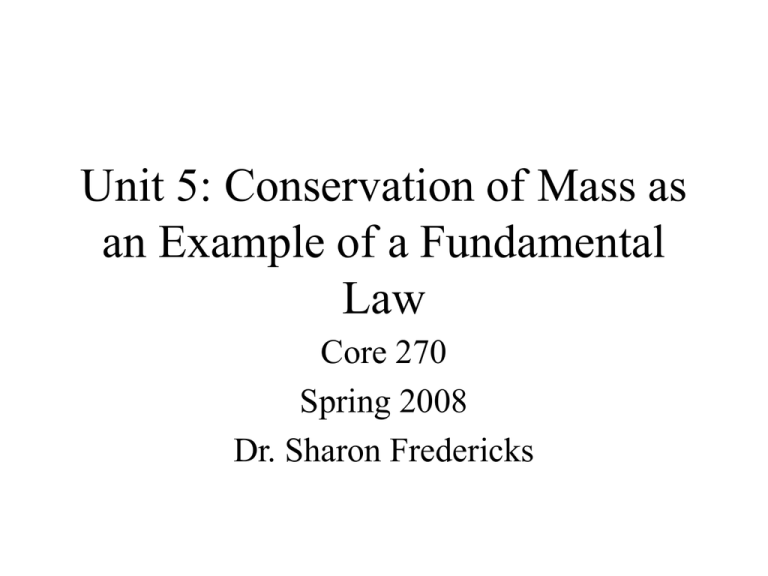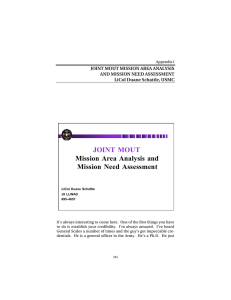Unit5 - King's College
advertisement

Unit 5: Conservation of Mass as an Example of a Fundamental Law Core 270 Spring 2008 Dr. Sharon Fredericks Matter and mass • Matter • Mass = measure of the amount of matter; relies on inertia (resistance to changing velocity) – Units: gram or kilogram, slug • Weight = depends on the strength of gravitational force; technically not the same as mass but ok for us – Units1: Newton, pound • An astronaut’s weight changes as he/she goes from Earth to the moon, but her/his mass doesn’t. • Close to the Earth, 1 kg of something has a weight of 2.2 lb 2 Figure Studying Matter • Properties – Size, color, temperature – Chemical composition: what matter is made of – Chemical reactivity: how matter behaves • Transformations – Physical change: one that does not alter the ___________________make-up of a substance • Phase change (melting, freezing, evaporating), dissolving – Chemical change: one that does alter the ___________________ make-up of a substance • New substance is formed Physical Figure 2.2 2 Change Chemical Figure 2.5 2 Change What do you think? • In the boxes below, each solid circle represents an atom of the same element. Each hollow circle represents an atom of a 2nd element. • The transformation from left to right is best viewed as a chemical change or physical change? Why? Sample problem Identify which are chemical changes and which are physical changes: • Mixing salt and water to make salt water • Steam condensing to water • Milk souring • Ignition of matches • Breaking of a dinner plate • Leaves turn red in Autumn States of Matter • 2 broad categories: solid & fluid – Solid: – Fluid: • Conversion of one state to another is called _______________________________________ • Solid Liquid = melting/freezing – Melting point = freezing point • Liquid Gas = boiling/condensing – Boiling point = vaporization temperature • Solid • Liquid Vapor = subliming/condensing Vapor = evaporating/condensing Changes of 2 Phase Heat is added in order to pull atoms or molecules a part for melting & evaporation. Heat is released during freezing and condensation as atoms & molecules “bond”. Sample Problem • Sulfur dioxide (SO2) is a compound produced when sulfur burns in air. It has a melting point of –72.7oC and a boiling point of –10oC. In what state does SO2 exist at room temperature (25oC)? How about at –11oC? Solution to Problem • Note that the scale is in Celsius and both the mp and the bp are negative numbers • As you go to the left, you increase in the negative direction. Your Turn • The melting point of the element bromine is –7.2 oC. Its boiling point is 58 oC. In what state does Br2 exist at room temperature (25oC)? How about at –11oC? Solution to Problem • Note that the scale is in Celsius. • The mp is negative; the bp is positive. So zero degrees Celsius is somewhere in between. • As you go to the left, you increase in negative numbers. As you go right, you increase in the positive numbers. Melting vs. Dissolving Melting Dissolving • Involves a solid to liquid transition at a specific temperature. • Only ONE substance (no solvent) • Ice water at 0 degrees C • Sugar(s) molten sugar at 365 degrees F (186 deg C) • One substance is mixed with another to form a solution • At least TWO substances involved • Salt + water salt water at all temperatures above room temperature – Aqueous solution Sample Problem • What is happening when you put an ice cube in your mouth? • What is happening when you put a sugar cube in your mouth? Conservation of Mass • • It is Fundamental Law • To be tested, the type of system has to be determined1: closed or open • Closed: matter can not enter or leave the system; • Open: Matter can enter and leave the system; most systems are open Concept Problem A piece of dry ice (solid carbon dioxide) is placed in an air-tight container and sealed shut. At room temperature, the solid changes to a vapor or sublimes. Is the mass of the carbon dioxide and container the same, less, or more after all the solid evaporates? Closed and Open Systems with respect to matter • Closed – Sealed glass bottle – Closed zip-lock bag • Open – – – – A room with an open window or door Car Ocean, sea, lake, pond, river Anything in which matter (remember gases like air) can flow in and out The 1 Earth • It can be considered an open system because we know that material from space can fall to Earth. Furthermore, the space shuttle, rockets, etc can leave and sometimes return • It can be considered a closed system for all intensive purposes because a fraction of 1% of matter is crossing the boundary. • This is a good ___________________________ and demonstrates that sometimes we settle for a description or law that is ___________________ _______________________________________ Law of Conservation of Mass for an Open System • mfin = mori + min – mout – – – – mfin = total matter in final condition of system mori = total matter in original condition of system min = matter that has been put into the system mout = matter that has been taken out of the system • If Dm = min – mout then • If morig is constant, then • Rearranging: • By tracking changes, Problem • A person has a checking account balance of $515.20. He took out $80 from the ATM, which he used for daily expenses. He bought $35.90 worth of groceries using his debit card (from checking) and paid his Visa bill ($52.88) and rent ($400). He deposited his weekly paycheck of $350. What was mori, min, mout, Dm, and mfin? Assume the amount of money=mass and use the formulas introduced. Your Turn A candy factory made 100 dozen chocolate truffles. It sent 30 dozen to the local candy store, 45 dozen to the candy store in the next town, and shipped out 4 dozen to a private customer. It placed the rest in its own factory store. The factory store sold 6 dozen during the first week of sales, but the private costumer sent back a dozen because she only wanted 3 dozen. What was the original amount (morig), the amount of candy that left the factory (mout), the amount of candy that came into the factory (min), the change of amount (Dm), and the final amount (mfin) of candy in the factory? Solution Exception to the law3 • In ____________________reactions, mass is not conserved and is converted to energy according to Einstein’s famous equation E=mc2. • In ________________________reactions mass is conserved, since in every case the mass-energy of the reactants is huge in comparison to the energy absorbed or released when they react. – “By way of example, a gram of TNT releases 4.16 kJ of energy when exploded. However, the rest-energy of a gram of TNT is 90 TJ, or about 20 billion times as much. This means that even if the products of a TNT explosion were stopped and allowed to cool to the original temperature, they would only lose 1 part in 20 billion in weight. This amount would be very difficult to measure.”3 Amalie (Emmy) 1 Noether • Brilliant mathematician – considered one of the most important in the 20th century • Established role of symmetry to laws of conservation with respect to the General Theory of Relativity • Could not officially teach in universities in Germany and was given a token salary after 10 years • Could not present any of her original work, including a ground breaking paper – a male colleague took her place References 1. Kelinsteuber, et al., Natural Science 5th edition, King’s College, PA, 2004. 2. Suchocki, J., Conceptual Chemistry, 2nd edition, Benjamin Cummings, 2004. 3. Wikipedia web site: http://en.wikipedia.org/wiki/Conservation _of_mass





